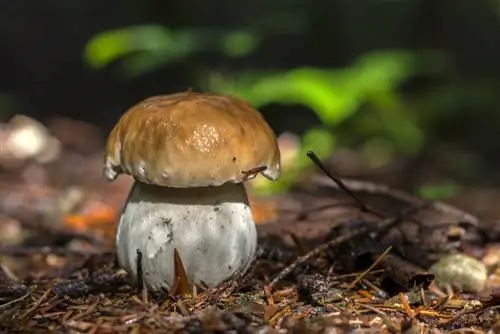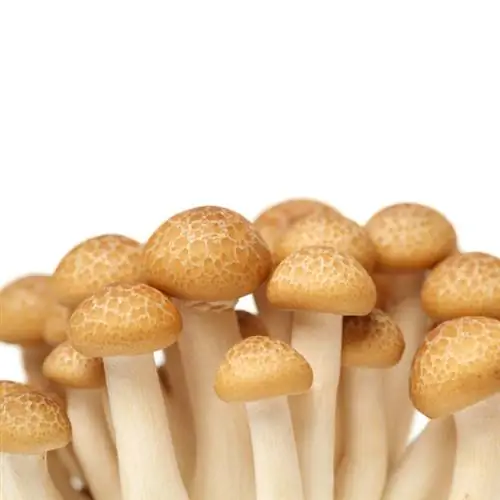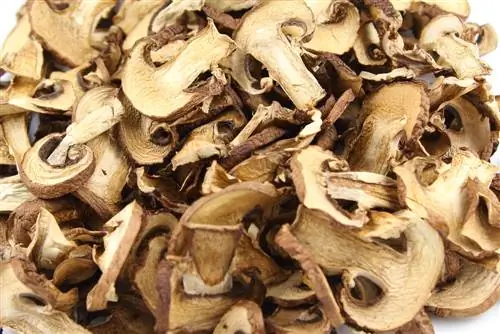- Author admin [email protected].
- Public 2023-12-16 16:46.
- Last modified 2025-01-23 11:21.
Foodies can hardly wait until porcini mushrooms are finally in season again. The noble mushroom is one of the most sought-after edible mushrooms, but in some years it is not easy to find. Fortunately, it can be preserved well and becomes even more aromatic when dried. When supplies gradually run out, it's time for fresh supplies.

When is the best time to find porcini mushrooms?
Boletus mushrooms grow in season from May/June to November, with the summer boletus (Boletus reticulatus) starting in May and the spruce boletus (Boletus edulis) can be found from July into November. Ideal conditions are moist weather and calcareous soils.
The porcini mushroom season starts in June
Basically, you can collect fresh porcini mushrooms between May / June and into November - provided the weather cooperates. A good boletus year begins with a wet spring. However, if it is too dry, the joy of autumn collecting will most likely be spoiled. By the way, the long season is because there are different types of porcini mushrooms that can be found in the forest at different times.
Summer porcini mushroom heralds the season
The so-called summer boletus (Boletus reticulatus) is the beginning. In some places and when the weather is suitable, it can be collected as early as May on calcareous soils and preferably near beech or oak trees. In contrast to the spruce boletus, the summer boletus has a matt, sometimes finely scaled cap skin. The stem, which has a clear net pattern, is also significantly darker. It is one of the first boletus of the year and is often heavily infested with maggots. If autumn is mild and warm, it sometimes still occurs in October.
Spruce porcini mushroom will follow from July
From July and, depending on the weather, until November, you can finally go in search of the much more well-known spruce boletus (Boletus edulis). Very young specimens - which are also known in technical language as embryos - often have their stems sunk deep into the ground, so that only the white or brownish cap sticks out. Mature specimens, on the other hand, can be recognized by their yellow to olive-green tube mouths and the elongated stem. Near pine trees you can find the rare pine boletus (Boletus pinophilus) with a reddish-brown cap and stem. The black boletus (Boletus aereus), which is also edible, has a strikingly dark, blackish cap.
Attention, risk of confusion
Inexperienced collectors often confuse the boletus with the inedible gall boletus (Tylopilus felleus). However, this has a bitter taste and, if consumed in large quantities, can cause severe gastrointestinal problems. You can distinguish it from the porcini mushroom by the following characteristics:
| Features | Common gall boletus | Spruce porcini mushroom |
|---|---|---|
| Hat | Surface matt, felty, color honey yellow, more or less light brown with gray tones | smooth to wrinkled, moist surface, whitish when young, then light brown to dark brown without red tones |
| Tubes | Mouths white when young, then pale to brown-pink, brownish when pressed | mouths whitish when young, then yellow to olive green |
| Stem | Cap-colored except for the lighter tip, with mostly coarse, brown-yellow netting. Shape cylindrical to club-shaped | white to light brownish, in the upper part with a clear white, fine-meshed net; young, usually bulbous, then club-shaped |
| Meat | white, hardly discoloring on average | white and firm when young, brownish and spongy under the skin of the hat when old |
| Smell | pleasant, but very bitter taste | pleasant, nutty taste |
| Occurrences | July to October on low-lime soils in coniferous forests | July to November, in coniferous and deciduous forests |
Tip
If the tubes of the supposed porcini mushroom turn blue when pressed, it is probably the chestnut boletus, which is also edible.






